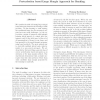JMLR
2012
12 years 10 months ago
2012
We consider the task of devising large-margin based surrogate losses for the learning to rank problem. In this learning to rank setting, the traditional hinge loss for structured ...
IACR
2011
13 years 7 months ago
2011
We analyze the internal permutations of Keccak, one of the NIST SHA-3 competition finalists, in regard to differential properties. By carefully studying the elements composing th...
ECCC
2011
14 years 2 months ago
2011
A family of permutations in Sn is k-wise independent if a uniform permutation chosen from the family maps any distinct k elements to any distinct k elements equally likely. Effici...
TIT
2010
14 years 2 months ago
2010
We investigate error-correcting codes for a the rank-modulation scheme with an application to flash memory devices. In this scheme, a set of n cells stores information in the permu...
JCT
2011
14 years 2 months ago
2011
Bona [6] studied the distribution of ascents, plateaux and descents in the class of Stirling permutations, introduced by Gessel and Stanley [14]. Recently, Janson [18] showed the c...
CORR
2011
Springer
14 years 2 months ago
2011
Springer
The paper describes a general glance to the use of element exchange techniques for optimization over permutations. A multi-level description of problems is proposed which is a fund...
105
click to vote
ALGORITHMICA
2011
14 years 2 months ago
2011
Abstract Given k permutations of n elements, a k-tuple of intervals of these permutations consisting of the same set of elements is called a common interval. We present an algorith...
SIAMDM
2010
14 years 6 months ago
2010
K¨orner and Malvenuto asked whether one can find n n/2 linear orderings (i.e., permutations) of the first n natural numbers such that any pair of them places two consecutive int...
LATINCRYPT
2010
14 years 6 months ago
2010
Abstract. Misty schemes are classic cryptographic schemes used to construct pseudo-random permutations from 2n bits to 2n bits by using d pseudo-random permutations from n bits to ...
JCT
2010
14 years 6 months ago
2010
Abstract. We present bijections between four classes of combinatorial objects. Two of them, the class of unlabeled (2 + 2)-free posets and a certain class of involutions (or chord ...



